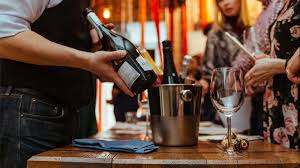Wine tasting is simply the subjective assessment and sensory evaluation of wine through taste. While the process of wine tasting itself is probably as old as the production itself, a formalized methodology to evaluate wine has slowly evolved from the 14th century onward.
The first official connoisseurs were French wine critics who visited wine-tasting establishments to evaluate the quality and taste of newly produced wines. Since then, wine tasting has developed into a professional qualification that winemakers are eager to promote and even wine drinkers are likely to take up themselves to satisfy their friends.
To undertake a proper wine tasting, it is important to remember not to touch the stems or skin of the grapes or any other of the natural receptacle for volatile oils (pleasant smells), such as the skin of the grapes or fruit pulp, nor to drink the wine itself (there is always the risk of becoming drunk from the fruit). Instead, one should simply look at the wine in the glass, savoring its appearance and smell, savoring its bouquet and flavor.
A wine tasting event is ideally conducted during the day; if you cannot attend in person, the best thing to do would be to check for fruit aromas in the air, as these can be detected easily using a smell test pen and a lighter fluid.
Before taking part in such an activity, it is important to understand certain basics about the process of wine tasting and the history of winery tours. Some wineries offer guided tours, which can be quite enlightening and informative, especially if they are aged in their vineyards.
Some other wineries may not offer any tours but will instead provide a guided tasting at their restaurant or a nearby vineyard. Either way, the basics of wine tasting can be learned during a private tasting tour, which can be more informative and entertaining than a guided tour.
What about Basics of Wine Tasting
